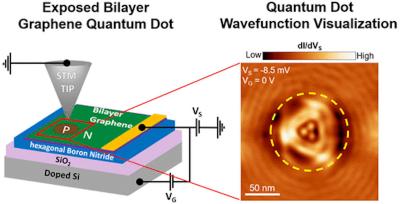Researchers at UC Santa Cruz have reported the first direct visualization of quantum dots in bilayer graphene, revealing the shape of the quantum wave function of the trapped electrons. The finding of this research could provide important fundamental knowledge, required for developing quantum information technologies based on bilayer graphene quantum dots.
 Image from Nano Letters
Image from Nano Letters
"There has been a lot of work to develop this system for quantum information science, but we've been missing an understanding of what the electrons look like in these quantum dots," said corresponding author Jairo Velasco Jr., assistant professor of physics at UC Santa Cruz.
A variety of systems are being explored as platforms for creating and manipulating qubits. Bilayer graphene is an attractive material because it is relatively easy to produce and work with, and quantum dots in bilayer graphene have desirable properties. "These quantum dots are an emergent and promising platform for quantum information technology because of their suppressed spin decoherence, controllable quantum degrees of freedom, and tunability with external control voltages," Velasco said.
Understanding the nature of the quantum dot wave function in bilayer graphene is important because this basic property determines several relevant features for quantum information processing, such as the electron energy spectrum, the interactions between electrons, and the coupling of electrons to their environment.
The research team used a method previously developed to create quantum dots in monolayer graphene using a scanning tunneling microscope (STM). With the graphene resting on an insulating hexagonal boron nitride crystal, a large voltage applied with the STM tip creates charges in the boron nitride that serve to electrostatically confine electrons in the bilayer graphene.
"The electric field creates a corral, like an invisible electric fence, that traps the electrons in the quantum dot," Velasco explained.
The researchers then used the scanning tunneling microscope to image the electronic states inside and outside of the corral. In contrast to theoretical predictions, the resulting images showed a broken rotational symmetry, with three peaks instead of the expected concentric rings.
"We see circularly symmetric rings in monolayer graphene, but in bilayer graphene the quantum dot states have a three-fold symmetry," Velasco said. "The peaks represent sites of high amplitude in the wave function. Electrons have a dual wave-particle nature, and we are visualizing the wave properties of the electron in the quantum dot."
This work provides important information, like the energy spectrum of the electrons, needed to develop quantum devices based on this system. "It is advancing the fundamental understanding of the system and its potential for quantum information technologies," Velasco said. "It's a missing piece of the puzzle, and taken together with the work of others, I think we're moving toward making this a useful system."

